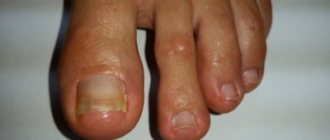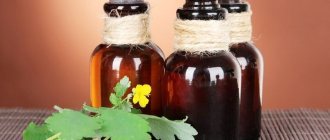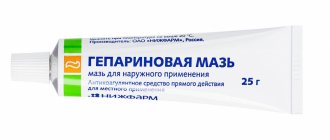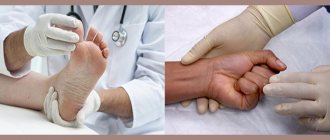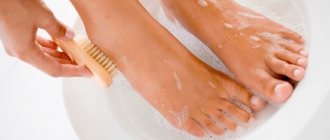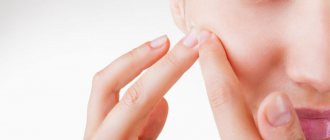Girls now always monitor the condition of their manicure, as it speaks about her image, sense of taste, and style. However, the natural plate is often covered with a decorative coating, which is why problems with it may not be noticeable until the next correction.
Detachment of the nail plate is a cosmetic defect that can be temporary, but not always. A large number of factors affect the fact that the nail moves away from the skin.
The later treatment is started, the more difficult it will be to restore the condition of the nails, which is why it is recommended to immediately consult a doctor.
What happens during onycholysis?
Onycholysis-detachment of the nail plate
Detachment is a violation of the integrity of the nail plates. form under their surface , which causes the nails to separate from the soft tissues of the fingers.
There is a complete or partial change in the color of the nail plates. They may become pale yellow, whitish-gray, or less commonly bluish or brown. At first, the upper part of the nail or its sides are peeled off as the disease develops , the defect reaches its base - the entire surface moves away from the nail bed. But more often than not, it doesn’t come to this, and the nail plate is not completely separated.
Symptoms
The clinical picture is typical and is characterized by detachment of the nail plate from the bed from the free edge in the lateral or distal sections to the nail hole. Visually, there is a change in the color of the nail from flesh to white, whitish-gray, which is due to the penetration of air into the subungual spaces. If microbes penetrate there instead of air, the color of the nail changes. Under the influence of bacteria, the nail becomes yellow, fungi give it a brownish tint, and greenish color is a pseudomonas infection. When a microbial infection of the nail plate occurs, its consistency also changes, it begins to deform and becomes rough.
Keratin and dirt accumulate in the space between the nail bed and the nail, subungual hyperkeratosis is formed, and an unpleasant odor occurs. The formation of foci of a secondary type of disease is possible. If only part of the nail comes off, this indicates the development of partial onycholysis, but if the entire nail is subjected to the process, they speak of a total form.
Possible diseases due to nail detachment
Detachment of the nail plate can occur in some diseases, both chronic and acute. The most common are:
|
These are systemic diseases. Onycholysis is also characteristic of:
|
What processes can be identified during onycholysis?
- Rejection of the plate from the bed in the area of the leading edge, detachment from the side and at the base of the holes.
- A healthy nail is transparent; if it turns whitish-gray, then there is air in the bed space.
- A change in color in the yellow-brown palette helps to suspect the presence of microbes.
- The greenish color is characteristic of Pseudomonas aeruginosa.
- With mycosis, the smoothness of the nail surface is lost, roughness appears, and the nail is also easily deformed.
- Hyperkeratosis gradually forms due to dirt and dead cells entering the subungual space.
- There is a risk of secondary foci of infection.
- Onycholysis is characterized by both complete and partial rejection of the plate.
Causes of onycholysis
The causes of detachment of the nail plate can be various factors of both infectious and non-infectious nature.
chemical factor for nail peeling
Non-infectious causes:
- Chemical – the disease manifests itself through frequent contact with household chemicals without the use of gloves or other substances. Such a product may be washing powder, nail polish, or nail polish remover.
- Mechanical – various injuries: strong blow, cutting, squeezing, habit of biting nails. In such cases, a hematoma (collection of blood) forms under the nail, which must be properly removed as soon as possible.
- Allergy. The same household products, latex, and nail polish can cause such a reaction. Often their peeling can be observed after coating with gel polish, which is popular today, but often causes allergies.
- Medications . This includes some groups of antibacterial drugs; the most common cause of nail splitting is treatment with fluoroquinolones.
- Manicures and pedicures performed incorrectly at home are also a common cause of onycholysis. Nails can begin to peel if you cut them carelessly, which leads to deformation, and when filing them, hold the file not perpendicular to the nail plate, but at an angle, and move the tool in different directions.
Onycholysis can be triggered by hormonal fluctuations, lack of vitamins and stressful situations.
Infectious causes include fungi, less commonly bacteria. In 40% of cases of the disease, onycholysis is caused by the first microorganisms. When they get on the nail plates, they destroy it, the nails begin to delaminate and break.
Poor quality materials are the cause of gel peeling
The most common cause of the problem is the use of low-quality material . The result is fragile, thin, transparent nails that crack and chip.
Many craftsmen complain that after using the topcoat, the gel begins to crack. The reason is the use of low-quality coating, or its components conflict with the base material. It is better to use all products from the same brand so that there is no difference in the elasticity of the finish and the sculptural layer.
Lack of vitamins
Deficiency of vitamins and various macro- and microelements can also provoke detachment of the nail plate. Their deficiency usually occurs when eating poor food.
The diet must contain foods high in iron, calcium, and zinc . large amounts of magnesium, vitamin D, and phosphorus is ideal , without which calcium absorption is impossible.
B, A and E , found in apples, butter and sunflower oil, seeds, dairy products, and nuts, are also important for healthy nails
Also in the diet there should be the presence of protein products, vegetables and fruits containing silicon, amino acids, zinc and folic acid.
Gel extensions - what kind of procedure is it?
Gel is a plastic material that is easy to work with. It allows you to do nail extensions both at home and in a beauty salon. As a result of the master’s work, the length of the nails increases, their shape changes, and the surface is smoothed.
Gel nail extensions
Gel extensions last up to 4 weeks ; the structure of this polymer resembles natural nails , and it looks much more natural than acrylic.
There are two methods of extension using gel. The first is a sticker of ready-made artificial plates (tips), and the second is an extension in shape.
This method requires durable stencils that are applied to the nails, and the gel is applied through the “window”. After the gel has completely hardened, the forms are removed, and the result is beautiful nails with a length longer than natural.
Diagnosis of onycholysis
examination by a dermatologist
If you notice detachment of the nail plate, you should contact a dermatologist to determine the cause of this problem. If during the diagnostic process the doctor discovers concomitant diseases, he will refer the patient to another specialist . This is necessary in order to eliminate the factors that provoke onycholysis.
At the first appointment, the dermatologist visually examines the nail plates. It happens that the doctor immediately recognizes a fungal infection of the nails and refers the patient for an analysis (scraping), which reveals the type of pathogen. After this, appropriate treatment is prescribed.
If examination of the nails does not reveal the cause of their detachment, diagnostic methods such as:
- taking samples to determine the presence of fungus, staphylococci and streptococci;
- a blood test to assess the general condition of the body.
Other instrumental and laboratory diagnostics are also possible, the choice of which is based on the most likely cause of onycholysis.
Secrets of quality extensions
Despite the apparent simplicity of the procedure, the effect of extensions is not always ideal. But usually any problems (gel detachment, chipping or dullness of the coating) are associated with non-compliance with technology and ignoring simple rules. To obtain high-quality artificial nails, you need to follow these tips:
Nail extension process
- If necessary, a trimmed manicure should be done 2 days before extensions or one day after the procedure. Even minor damage should be avoided on the cuticle.
- hand creams a day before extensions, since some components tend to be released from the skin in the future. For this reason, the gel can peel off.
- Taking antibiotics and hormones does not go well with the procedure, and it is better to postpone it.
- Gel extensions cannot be done on sick nails .
There are diseases in which gel detachment and other nail problems are not uncommon. These include diabetes mellitus, heart and vascular diseases, hormonal imbalances, herpes, Graves' disease.
Clinical picture
Symptoms of onycholysis depend on the cause that caused it.
In case of a disease that occurs after a nail injury, the following may occur:
- pain syndrome;
- hematoma formation;
- discoloration and weakening of the nail plate;
- bleeding.
If onycholysis is caused by an infection, you may experience:
- thickening of the nail plate;
- change in nail color, it becomes green or yellow;
- redness of the tissue around the nail plate;
- feeling of pain;
- unpleasant odor;
- discharge from under the nail plate.
Symptoms common to all types of onycholysis:
- the nail plate changes color, first stratifies in its upper part;
- unevenness, change in the border line dividing the nail plate into pink and white parts;
- the skin under the nail thickens;
- pain occurs only with secondary infection, due to microorganisms getting under the detached nail plate.
How to provide yourself with first aid, what should you do?
Find out what to do if you receive a mechanical or chemical injury to your nail, it falls off or begins to peel off, from the following instructions:
- Apply a cold compress to the injured area.
- Wrap your finger with an elastic bandage - it is acceptable to slightly tighten it.
- If the nail begins to peel off, you can apply a gauze compress soaked in apple cider vinegar and vegetable oil.
The situation is more complicated if the cause of nail detachment is a fungus. Here you can no longer do without medical consultation. Remember that self-medication is simply dangerous.
Only a specialist can select an effective antifungal drug. If the nail has almost come off, simply steam your feet in a basin with warm water and medicinal herbs so that the plate comes off on its own. A decoction of:
- lemon balm;
- chamomile;
- St. John's wort;
- calendula.
First aid for a nail injury
Hematoma-bruised nail
to place your hand or foot under a stream of cold water as quickly as possible . This is necessary to prevent the appearance of a hematoma under the nail , which provokes detachment of the nail plate. The injured limb should be kept in the cold for at least 15 minutes to constrict the blood vessels and eliminate pain.
To avoid swelling, an iodine mesh is applied to the skin and a tightening bandage is applied. This will minimize the risk of the nail moving away from the nail bed.
puncture to release blood from a hematoma
If a hematoma has formed, you should consult a doctor for a minor surgical intervention: a small hole is made in the nail so that the blood that has accumulated under it can come out.
If it is impossible to visit a specialist, you can try to carry out these manipulations at home under the condition of complete sterility . To do this, you need to thoroughly wash your hands and treat the bruise with an antiseptic solution, take a sterile needle, and heat it over a fire. After making a hole in the nail plate, remove the blood from under it. Then re-treat the nail.
Nail removal
In particularly advanced cases, when the infection is severe or the nail has almost completely come away from the skin, the doctor may recommend surgery to amputate the horny plate. The procedure is painful and is performed under local anesthesia. During the recovery period, therapeutic bandages are applied to the finger using antibacterial agents.
There is a chemical way to remove damaged nails. It is based on the use of keratolytic components that dissolve the horny part. You can purchase drugs such as Nogtimycin, Nogtevit at the pharmacy and, following the instructions, remove the nail yourself.
Removing a nail with a pedicure machine
You can also get rid of the nail plate when it peels off using a hardware pedicure or laser (see photo of big toe nail removal). Find out if this procedure is performed at your nearest cosmetology clinic. Within 2-3 months, a new nail will begin to grow, and if you have eliminated the root cause of the disease, you can guarantee that it will be healthy.
To quickly restore the stratum corneum, it is recommended to take a gelatin solution. Pour in 2 tsp. edible gelatin 100 g of warm water and leave to swell. Then heat the solution in a water bath, add another 100 g of water. When the crystals are completely dissolved, add 1 tsp. lemon juice and drink. Drink gelatin an hour before meals in the morning for 2 weeks. Then they take a break for a week and repeat the course again.
Treatment with folk remedies
Alternative medicine methods are used as additional methods for symptomatic treatment and disinfection.
orange juice with salt
A good remedy for strengthening nails is a solution of orange juice, a tablespoon of salt and 60 ml of warm mineral water. 5 drops of iodine are added to these components. Everything gets mixed up. Keep your fingers in this mixture for at least 10 minutes.
Kombucha has analgesic, anti-inflammatory and antibacterial properties. You can make a paste from it. Take a small part, cleared of films. Grind it up. Apply the resulting mass to the affected areas 2-3 times a day.
Several additional ways to treat a bruised nail at home in the video.
Recovery
Recovery time depends on the severity of the injury and the speed of recovery.
- In cases of non-infectious etiology, therapy lasts up to six months.
- The treatment period for mycotic lesions lasts from three months to a year. Treatment must be complete, only then is absolute recovery possible.
- If onycholysis appears as a result of existing diseases, then complex treatment is prescribed and the treatment process becomes more complicated.
- The growth of new nail plates lasts on average from 3 to 5 months.
Measures to prevent nail plate detachment
To prevent a disease such as onycholysis, you must adhere to the following rules:
- You should only wear shoes that “breathe.”
- Socks should be chosen from materials that are highly breathable (cotton) . They should be changed every day.
- Do not wear tight shoes.
- After contact with water, wipe your hands or feet dry.
- When working with household chemicals, you should always wear gloves and dry them afterwards.
- It is necessary to properly organize your diet, excluding canned food, fatty and spicy foods . Necessary products are high in vitamins A, B, D, E, calcium and micro- and macroelements that promote its absorption, polyunsaturated acids.
- Treat with antibiotics as little as possible.
- It is imperative to treat chronic diseases in the acute phase.
- Avoid stressful situations, overwork, lack of sleep.
Thus, if preventive measures were not followed and symptoms of onycholysis appear, you should consult a specialist who will diagnose and prescribe adequate complex therapy. Self-medication in this case should not be allowed, since there are many reasons for the detachment of the nail plates, and it is impossible to establish them independently.
Why does the nail peel off?
There are many factors that provoke the development of onycholysis. The separation of the nail plate could be caused by:
- The nail on the thumb is moving away from the skin.
Injury to the phalanx of the finger or the stratum corneum. Damage could occur due to mechanical or chemical influence. As a result of an impact, strong pressure or burn, the vital activity of cells is disrupted, tissue necrosis occurs and the nail peels off. - Walking in tight shoes. If the thumbs are constantly in a compressed state, blood circulation is disrupted, nutrition of the horny plate deteriorates, and tissue rejection occurs.
- Poor quality pedicure. Injury can result from careless sharpening or careless cutting of the nail.
It's possible that it's not just your big toenails that are peeling, but several of your toenails at once. The cause of this pathology may be:
Psoriasis of toenails
- Dermatological diseases - eczema or psoriasis of the stratum corneum.
- Long-term use of tetracycline and fluoroquinolone antibiotics.
- Chronic diseases of the cardiovascular, endocrine, nervous or digestive systems that affect the condition of the nails.
- Fungal infection of the feet, localized on the horny plate.
Most often, toenails detach from the skin due to a parasitic fungus. Before treating an infection, you need to find out what pathogen is causing it.




